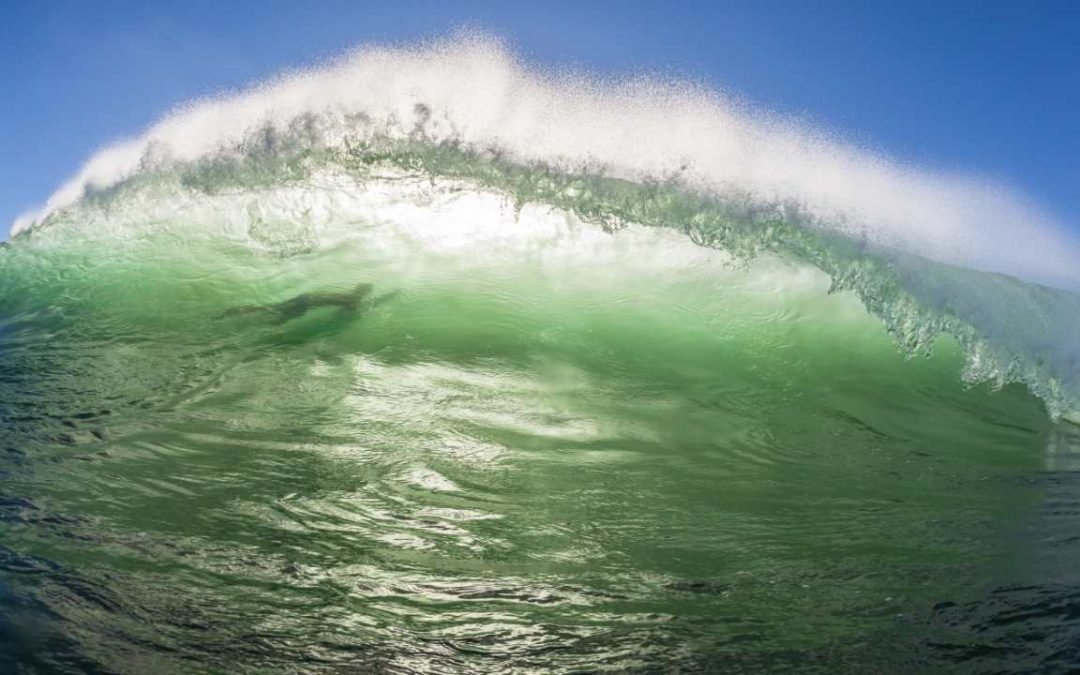Itʻs one of the most classic lines in one of the most classic Hollywood surf movies ever made. “When the wave breaks here, donʻt be there, or your gonna get smashed,” some of the sage advice uttered by one of surfingʻs greatest philosophers, Turtle in the movie North Shore.
Itʻs one of the things that scare surfers the most, paddling back out to the lineup only to see a giant wave heading straight for you! Whatʻs a surfer to do when a wave is about to break on them?
When you are faced with the inevitability of wave thatʻs about to break on you, the most important thing is not to panic. Relax, focus on your breath and paddle straight for the wave without hesitation, duckdiving underneath it just before it reaches you.
I know, thatʻs easier said than done. The first instinct might be to ditch your board or point it back toward the beach, but that would be a big mistake.
Best thing you can do is arm yourself with knowledge BEFORE putting yourself into the position of getting pounded by the surf. Lucky for you, youʻre in the right place. Read on so youʻre ready for the next time you paddle out.
How To Get Past A Breaking Wave?
When you know and accept that you have an oncoming battle with the ocean, tap into your mental strength and take it as a challenge, stay positive and remind yourself of these strategies and skills:
- Stay in control and don’t panic. When you start to feel short of breath, remember to take long, deep breaths. Calm and controlled breathing will help keep your heart rate low, oxygenate your muscles and preserve your energy.
If you want to take your breath work in the surf to another level, then you need to sign up for the Surf Breathwork Mastery Program. It will get you prepared to tackle some of the biggest surf you ever seen.
- Aggressively paddle straight towards the oncoming wave and meet it with momentum. The worst thing you can do is hesitate and second guess yourself.
Try to keep your strokes clean and efficient between waves, and use these small pockets of time to your advantage. Use your energy sparingly.
- Execute a strong cobra press-up into a plank position when charging through smaller waves. Pressing up and away from your board allows the white water to pass between you and the board with less resistance.
- On bigger waves, either turtle roll if you are on a big board or duck dive if you have a small board, whilst maintaining proper form and technique at all times. Use the buoyancy of your board to your advantage here!
If you want to learn more about these techniques for getting through waves, check out this post, The Complete Guide To Paddling Back Out.
- If all else fails and you feel like you’ve no other choice, then bail (ensuring no one is around you first). Don’t forget to cover your head and curl into a ball shape to protect yourself.
It’s important to note that waves come in sets, ranging from around 3 to 10 waves in some cases and usually come every 7 – 15 seconds. Deal with each wave as it comes, until you’re out the other side.
Mental and physical fatigue will start to come into play the longer you’re out there, regardless of whether or not you’re a beginner or life long surfer. Thatʻs one of the reasons we took up surfing anyway, right? To test yourself against mother nature?
What Exactly Is A Breaking Wave?
When waves travel in from deep to shallow water, they interact with the shape of the ocean floor below them. There are typically 3 different kinds of breaking waves:
Mushy wave – with a flatter, gently sloping ground underneath, these waves come in long and slowly and spill over the front.
Hollow wave – also known as barrels or tubes in the surf world, these are waves that approach deep water from shallow water in a short space of time, slowing down so fast that the wave usually falls as a curled shape with increased energy.
Surging wave – when the shore is steep, these waves approach with less amplitude, and so, don’t spill over or curl, but instead build up and soar rapidly up the beach, with little to no foam or spray.
We have all heard of the impact zone when we’re out there surfing. This is the point where the lip of a breaking wave hits the flat water below, and so ultimately is the point when the wave is at its most powerful and potentially dangerous stage. So keep an eye on this.
Ways To Prepare For A Breaking Wave In Advance
Treat the ocean like you would treat an exam, study it! This might sound silly, but if you research the area beforehand, it gives you an upper hand when you’re out there.
Mentally prepare yourself to approach and break through an impact zone. Observe the waves before going out and ask the locals or more experienced surfers who know the waters if they have any tips or tricks they can share.
Practice your turtle rolls and duck dives on small waves every chance you get so that when the time comes for you to take on the bigger and stronger waves, you’ll have mastered your technique and have the skill set to succeed. Definitely get yourself a good leash like this one just in case your attempts are unsuccessful.
I remember constantly having a battle with myself when I was just starting out when I saw big waves heading toward me as I paddled out. Turn around or paddle towards it? Once I finally got the hang of duck diving, I was no longer hesitant. The best thing everytime was to face them head on.
Improving your paddling power might also help. Luckily for you, I already put together a guide to do just that. Be sure to check it out!
Other Ways To Prepare For Breaking Waves
The sea can be pretty relentless, and it’s not only the size of the breaking waves that you should focus on but also:
- The frequency and angles at which the waves are coming at you.
- Rip currents.
- Rocks and sharp reefs.
- Other surfers around you.
So keep an eye out for these factors to make your experience as smooth as possible.
My last and maybe most important tip is to signal for help if your gut tells you that you need it, in other words, leave your ego on the shore. Learn to love and respect the powerful nature of the ocean.
This is an opportunity to turn something that initially is perceived as negative into a learning experience. We are all human with the tendency to give up, but you must remember that your body can keep going far longer than what your brain is telling you. Don’t quit!
By doing things the correct way and focusing on the main task at hand, you’ll find yourself tackling the breaking waves with precision, resulting in you having more energy in the tank for what’s important; surfing the waves.



